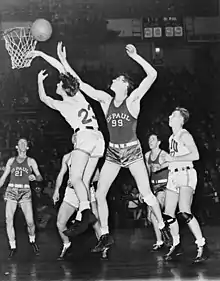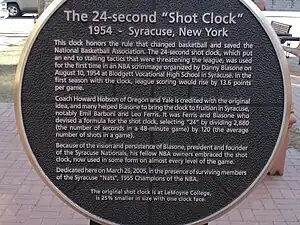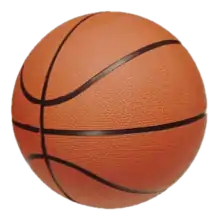.JPG.webp)
.JPG.webp)
.JPG.webp)
A shot clock is a countdown timer used in a variety of games and sports, proving a set amount of time that a team may possess the object of play before attempting to score a goal. Shot clocks are used in several sports including basketball, water polo, lacrosse, poker, ringette, korfball, tennis, ten-pin bowling, and various cue sports. It is analogous with the play clock used in American and Canadian football, and the pitch clock used in baseball. This article deals chiefly with the shot clock used in basketball.
The set amount of time for a shot clock in basketball is 24–35 seconds, depending on the league. This clock reveals how much time a team may possess the ball before attempting to score a field goal. It may be colloquially known as the 24-second clock, particularly in the NBA and other leagues where that is the duration of the shot clock. If the shot clock reaches zero before the team attempts a field goal, the team has committed a shot clock violation, which is penalized with a loss of possession.
At most professional and collegiate basketball courts the shot clock is displayed to the players and spectators in large red numerals below the game clock on a display mounted atop each backboard. In some collegiate and amateur facilities this display might be located on the floor or mounted to a wall behind the end line. A shot clock is used in conjunction with a game clock but is distinct from the game clock which displays the time remaining in the period of play.
The shot clock was originally introduced in the NBA in 1954 as a way to increase scoring and reduce stalling tactics that were commonly used before its inception. It has been credited with increasing fan interest in the then-fledgling league, and has since been adopted at most organized levels of basketball.
Definition
The shot clock is a digital clock that displays a number of seconds. The shot clock is usually displayed above the backboard behind each goal, allowing offensive players to see precisely how much time they have to shoot and officials to easily determine whether buzzer beaters should be counted. The NBA specifies that a transparent shot clock and game clock that displays said times on both sides be part of the backboard assembly, and FIBA, EuroLeague, and many venues use this arrangement.
Three signals indicate when the time to shoot has expired:
- A value of 0.0 on the shot clock itself
- An audible horn distinct from the scoreboard operator's signal for end of period and substitutions
- A yellow strip of lights (LEDs) on the backboard. The NBA (since 2011) and FIBA (since July 2018) require this. This is not explicitly required in the NCAA, although some venues will use the red LEDs surrounding most shot clocks or on the backboard (used in the NBA to signal the end of period) to denote a shot clock violation.
In the final five seconds to shoot, the shot clock displays tenths of seconds. This was adopted in the 2011–12 NBA season.[1]
History
The NBA has had a 24-second limit since 1954. FIBA introduced a 30-second shot clock in 1956 and switched to 24 seconds in 2000. The Women's National Basketball Association (WNBA) had a 30-second clock originally and switched to 24 seconds in 2006. Collegiate basketball uses a 30-second shot clock (details below).
Background

The NBA had problems attracting fans (and positive media coverage) before the shot clock's inception.[2]: 23–31 Teams in the lead were running out the clock, passing the ball incessantly. The trailing team could do nothing but commit fouls to recover possession following the free throw. Frequent low-scoring games with many fouls bored fans. The most extreme case occurred on November 22, 1950, when the Fort Wayne Pistons defeated the Minneapolis Lakers by a record-low score of 19–18, including 3–1 in the fourth quarter.[3] The Pistons held the ball for minutes at a time without shooting (they attempted 13 shots for the game) to limit the impact of the Lakers' dominant George Mikan. It led the St. Paul Dispatch to write, "[The Pistons] gave pro basketball a great black eye."[4]: 31–2 NBA President Maurice Podoloff said, "In our game, with the number of stars we have, we of necessity run up big scores."[4]: 33 A few weeks after the Pistons/Lakers game, the Rochester Royals and Indianapolis Olympians played a six-overtime game with only one shot in each overtime: in each overtime period, the team that had the ball first held it for the entirety of the period before attempting a last-second shot. The NBA tried several rule changes in the early 1950s to speed up the game and reduce fouls before eventually adopting the shot clock.
Creation
In 1954 in Syracuse, New York, Syracuse Nationals (now the Philadelphia 76ers) owner Danny Biasone and general manager Leo Ferris experimented with a 24-second shot clock during a scrimmage.[5][6] Jack Andrews, longtime basketball writer for The Syracuse Post-Standard, often recalled how Ferris would sit at Danny Biasone's Eastwood bowling alley, scribbling potential shot clock formulas onto a napkin.[7] According to Biasone, "I looked at the box scores from the games I enjoyed, games where they didn't screw around and stall. I noticed each team took about 60 shots. That meant 120 shots per game. So I took 2,880 seconds (48 minutes) and divided that by 120 shots. The result was 24 seconds per shot."[3][8][2]: 29 Ferris was singled out by business manager Bob Sexton at the 1954 team banquet for pushing the shot clock rule. Biasone and Ferris then convinced the NBA to adopt it for the 1954–55 season, a season in which the Nationals won the NBA Championship.
Use and reaction


When it was introduced by the NBA, the 24-second shot clock made players so nervous that it hardly came into play, as players were taking fewer than 20 seconds to shoot. According to Syracuse star Dolph Schayes, "We thought we had to take quick shots – a pass and a shot was it – maybe 8–10 seconds... But as the game went on, we saw the inherent genius in Danny's 24 seconds – you could work the ball around [the offensive zone] for a good shot."[2]: 29
The shot clock, together with some rule changes concerning fouls, revolutionized NBA basketball. In the last pre-clock season (1953–54), teams averaged 79 points per game; in the first year with the clock (1954–55), the average was 93 points,[3] which went up to 107 points by its fourth year in use (1957–58).[2]: 28 The advent of the shot clock (and the resulting increase in scoring) coincided with an increase in attendance, which increased 40% within a few years to an average of 4,800 per game.[4]: 33–4
The shot clock received near-universal praise for its role in improving the style of play in the NBA. Coach and referee Charley Eckman said, "Danny Biasone saved the NBA with the 24-second rule."[9] Boston Celtic all-star Bob Cousy said, "Before the new rule, the last quarter could be deadly. The team in front would hold the ball indefinitely, and the only way you could get it was by fouling somebody. In the meantime, nobody dared take a shot and the whole game slowed up. With the clock, we have constant action. I think it saved the NBA at that time. It allowed the game to breathe and progress."[10] League president Maurice Podoloff called the adoption of the shot clock "the most important event in the NBA."[3] The league itself states, "Biasone's invention rescue[d] the league."[9]
Models
Originally, the shot clocks used in the NBA were usually 2-sided in a black box. But around 1995, 4-sided cube and 3-sided triangular shot clocks began to be used, and would be in most of the arenas by the turn of the millennium. The main producer was Daktronics. By 2010, the 2-sided transparent shot clock was getting popularity. In the 2014-15 season, the NBA signed a deal with Tissot, a Swiss watch company, to use the 2-sided transparent shot clock, which was thinner than its predecessors. But in many international leagues and the colleigate level, the older 3-sided and 4-sided shot clocks are still in use.
Adoption by other leagues
Two later pro leagues that rivaled the NBA adopted a modified version of the shot clock. The American Basketball League used a 30-second shot clock for its two years in existence (1961–1963). The American Basketball Association also adopted a 30-second clock when it launched in 1967–68, switching to the NBA's 24-second length for its final season (1975–76).
From its inception in 1975, the Philippine Basketball Association adopted a 25-second shot clock. This was because the shot clocks then installed at the league's main venues, the Araneta Coliseum and Rizal Memorial Coliseum (the latter no longer used by the league), could only be set at 5-second intervals. The league later adopted a 24-second clock starting from the 1995 season. The Metropolitan Basketball Association in the Philippines used the 23-second clock from its maiden season in 1998. In Philippine college basketball, the NCAA Basketball Championship (Philippines) and the UAAP Basketball Championship adopted a 30-second clock, then switched to 24 seconds starting with the 2001–02 UAAP season 64, the first season to start after the FIBA rule change in 2001.
Operation
The shot clock begins counting down when a team establishes possession, and stops any time the game clock stops (e.g., timeouts, violations, fouls). The offensive team must attempt to score a field goal before the shot clock expires; otherwise, the team has committed a shot clock violation (also known as a 24-second violation in leagues with a 24-second shot clock) that results in a turnover to their opponents. An important distinction is that there is no violation if the ball is in flight to the basket when the shot clock expires, as long as the ball leaves the player's hand before the shot clock expires and the ball proceeds to go into the basket or touch the basket rim.
The shot clock resets to its full length at the start of each period and whenever possession changes to the opposite team such as after a basket is scored, the defense steals the ball or recovers a rebound, or the offense commits a foul or violation. The full length varies by country, level of play, and league; see the table below. The shot clock does not reset if a defender makes short contact with the ball (e.g., an attempted steal or a tipped pass) but the offense retains possession, or if a shot attempt misses the rim entirely and airballs. The shot clock also resets when the offense retains possession after a missed field goal or free throw, or on certain fouls or violations that give the offense an inbounds pass in their frontcourt.
If the offensive team is fouled and the penalty does not include free throws but just an in-bounds pass, the shot clock is reset. There are several cases where the offense is not given a full 24 seconds. The shot clock is instead set to 14 following an offensive rebound.[11]: 7-IV-d FIBA adopted this in 2014 and the NBA adopted in 2018.[12] The WNBA also observes this rule. In several other cases where the offense inbounds the ball in its frontcourt (such as a foul by the defense not resulting in free throws), the offense is guaranteed 14 seconds.[11]: 7-IV-e The shot clock is increased to 14 if it showed a shorter time.
On a held ball (whether decided by a jump ball or a possession arrow), the state of the shot clock depends on which team gets possession of the ball.
- If the defensive team acquires possession, the shot clock is reset, as it is on any other change of possession.
- If the offense retains possession, the shot clock is not reset, because there was no change of possession. However, in Euroleague, the NBA, and WNBA, the shot clock is topped up to 14 seconds, as described above for a frontcourt inbounds pass.
Near the end of each period, if the shot clock would ordinarily display more time than there is remaining in the period, the shot clock is switched off. During this time, a team cannot commit a shot clock violation.
The shot clock apparatus itself is considered out of bounds and not part of the backboard. The shot clock operator sits at the scorer's table. This is usually a different person from the scoreboard operator, as the task requires concentration during and after the shot attempt. In the 2016-17 NBA season, a new 'official timekeeper' deal for the NBA with Swiss watch manufacturer Tissot introduced technology to unify the keeping of the shot clock and the game clock.[13] Tissot also became official timekeeper for the WNBA in the 2017 season.
Collegiate rules
American collegiate basketball uses a 30-second shot clock, while Canadian university basketball uses a 24-second clock.
In men's collegiate basketball, there was initial resistance to the implementation of a shot clock for men's NCAA basketball, due to fears that smaller colleges would be unable to compete with powerhouses in a running game. However, after extreme results like an 11–6 Tennessee win over Temple in 1973, support for a men's shot clock began to build.[14] The NCAA introduced a 45-second shot clock for the 1985-86 season;[15] several conferences had experimented with it for the two seasons prior.[16] It was reduced to 35 seconds in the 1993–94 season,[17] and 30 seconds in the 2015–16 season.[18] The NAIA also reduced the shot clock to 30 seconds starting in 2015–16.[19]
Women's collegiate basketball (at the time sanctioned by the Commission on Intercollegiate Athletics for Women) used a 30-second shot clock on an experimental basis in the 1969–70 season, officially adopting it for the 1970–71 season.[20]
The NCAA specifies 20 seconds rather than 30 after stoppages where the ball is already in the frontcourt. In 2019, it added offensive rebounds to this list.[21]
US high schools rules
The National Federation of State High School Associations (NFHS), which sets rules for high school basketball in the U.S., does not mandate the use of a shot clock, instead leaving the choice to use a clock and its duration up to each individual state association. In concert with this, the "stall ball" strategy can be used in a state or league, but depending on the organization, itself comes with restrictions on its use by the game officials, with overuse of it often being whistled as a foul or an unsportsmanlike act. Others may allow stalling completely, at the risk of fan disinterest.
As the cost of a shot clock system can be cost-prohibitive, its use in high schools has been debated on that consideration and not the flow of the game. While previous proposals for a national shot clock had been denied by the NFHS as recently as 2011,[22] in the spring of 2021 the NFHS agreed to allow its member associations the option of a shot clock, with a mandatory 35-second duration, starting in 2022–23.[23]
As of August 2021, 11 states either require a shot clock in high school competition or will begin using one starting in 2022–23: California, Georgia, Iowa, Maryland, Massachusetts, Nebraska (Class A only), New York, North Dakota, Rhode Island, South Dakota, and Washington.[22][24] Before 2022–23, the District of Columbia used a 30-second shot clock for public school (DCIAA) competition, charter school competition (as of 2018–19), and for the DCSAA State Tournament, where public, private, and charter schools compete for the championship of the District of Columbia.
Shot clock length
Shot clock length in basketball
| Organization | Duration |
|---|---|
| NBA | 24 seconds |
| WNBA | |
| WBDA | |
| U Sports (Canadian universities) | |
| NCAA, NAIA, USCAA, etc. | 30 seconds |
| United States high school basketball | 35 seconds (some states only) |
| FIBA | 24 seconds 12 seconds (3x3 half-court)[25] |
Shot clock length in other sports
| Sport | Organization | Duration |
|---|---|---|
| Lacrosse | MLL (defunct) | 60 seconds |
| PLL | 52 seconds | |
| NLL | 30 seconds | |
| NCAA Men's | 80 seconds[26] | |
| NCAA Women's | 90 seconds[26] | |
| Australian rules football | AFL | 30 seconds[27] |
| Ringette | International Ringette Federation (IRF) | 30 seconds |
| Water polo | FINA | 30 seconds |
| Canoe polo | ICF | 60 seconds |
| Ten-pin bowling | PBA | 25 seconds (only used on TV) |
| Korfball | IKF | 25 seconds |
| Tennis | ITF | 25 seconds |
| Snooker | Snooker Shoot Out | 15 seconds (first five minutes) 10 seconds (last five minutes) |
| Carom billiards (three-cushion billiards) |
40 seconds[28] (3 time-outs (40 sec.) possible) | |
| Poker | World Poker Tour | 30 seconds 99 seconds (optional)[29] |
Related concepts
A related rule to speed up play is that the offensive team has a limited time to advance the ball across the half-court line (the "time line").
See also
- Pitch clock, used in baseball
- Play clock, used in American and Canadian football.
- Four corners offense, offensive stall strategy in basketball
- Stall count, used in the sport of Ultimate.
References
- ↑ Zillgitt, Jeff (December 24, 2011). "New points of emphasis in NBA officiating". USA Today. Retrieved February 4, 2012.
- 1 2 3 4 Pluto, Terry (1992). Tall Tales: The Glory Years of the NBA, in the Words of the Men Who Played, Coached, and Built Pro Basketball.
- 1 2 3 4 "History of the Shot Clock" Archived April 24, 2012, at the Wayback Machine NBA.
- 1 2 3 Pomerantz, Gary M. (2005). Wilt, 1962: The Night of 100 Points and the Dawn of a New Era. New York: Crown. ISBN 1-4000-5160-6.
- ↑ "NBA.com: 24-Second Shot Clock Rescues League". www.nba.com. Retrieved November 3, 2015.
- ↑ "National efforts to honor Syracuse hoops pioneers: Good day to remember Earl Lloyd, Leo Ferris". syracuse.com. 31 October 2015. Retrieved November 3, 2015.
- ↑ "A question for a Hall of Fame dinner in Syracuse: When will Leo Ferris make it in?". syracuse.com. 16 October 2012. Retrieved November 3, 2015.
- ↑ "Long-forgotten Leo Ferris helped devise NBA's 24-second clock, first used 61 years ago today". ESPN.com. 30 October 2015. Retrieved November 3, 2015.
- 1 2 "1954–55 SEASON OVERVIEW" NBA.
- ↑ "History of the Shot Clock". NBA Media Ventures, LLC. Archived from the original on April 24, 2012. Retrieved April 8, 2013.
- 1 2 "RULE NO. 7: Shot Clock". NBA. 15 October 2018.
- ↑ NBA implements FIBA's 14-second shot clock rule, FIBA.basketball
- ↑ "NBA, watchmaker Tissot announce multiyear partnership". ESPN. 5 October 2015. Retrieved February 23, 2016.
- ↑ Strange, Mike (2007-11-07). "Temple set stage for shot clock". The Knoxville News-Sentinel. Scripps Interactive Newspaper Group. Archived from the original on November 9, 2007. Retrieved January 13, 2012.
- ↑ Crowley, Anne S. (April 3, 1985). "NCAA adopts shot clock for next year". Spokesman-Review. (Spokane, Washington). Associated Press. p. C3.
- ↑ Cour, Jim (April 5, 1984). "Shot clock put on hold by colleges". Spokesman-Review. (Spokane, Washington). Associated Press. p. 25.
- ↑ Official 2008 NCAA Men's Basketball Records Book, p. 278
- ↑ "Shorter shot clock, fewer timeouts among changes coming in 2015-16". ESPN.com. June 8, 2015. Retrieved June 9, 2015.
- ↑ "Rule changes for NAIA, too". The Salina Journal. Associated Press. June 10, 2015 – via News OK.
- ↑ Official 2008 NCAA Women's Basketball Records Book, p. 245
- ↑ Katz, Andy (November 5, 2019). "The men's college basketball rule changes to know about this season". NCAA.
- 1 2 Halley, Jim (May 5, 2011). "Focus on high school shot clock heats up as states make move – USATODAY.com". USA Today. ISSN 0734-7456. Retrieved December 31, 2011.
- ↑ "Shot Clock Allowed By State Adoption for High School Basketball in 2022-23" (Press release). National Federation of State High School Associations. May 13, 2021. Retrieved August 12, 2021.
- ↑ Southard, Dargan (August 10, 2021). "IHSAA, IGHSAU release joint statement on shot clock coming to Iowa high school basketball". Iowa City Press-Citizen. Retrieved 2021-08-12.
- ↑ "Article 8 Stalling" (PDF). 3x3 Rules of the Game. FIBA. January 13, 2012. p. 2. Retrieved April 11, 2013.
- 1 2 Lee, Edward (September 12, 2018). "Time is now: NCAA approves 80-second shot clock for men's lacrosse". The Baltimore Sun. Archived from the original on February 14, 2019. Retrieved February 13, 2019.
- ↑ "AFL to crack down on deliberate time wasters". afl.com.au. 6 July 2018. Retrieved 2022-08-13.
- ↑ "Official Tournament Rules" (PDF). Union Mondiale de Billard (UMB). p. 4. Retrieved April 30, 2017.
- ↑ "Gamingsupport.com: Poker Shot Clock". www.gamingsupport.com. Retrieved January 30, 2020.
External links
- "RULE NO. 7: Shot Clock". NBA. 15 October 2018. Retrieved December 18, 2018.
- 24 Seconds to Shoot snopes.com
